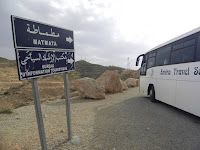The second book is written by Johan Tell, and is called “Träd kan rädda världen” (Trees Can Save the World) where the theme is very much the same as in “100 Ways to Save the World”. After reading it, you really feel like planting a tree and build a wooden house. More than half of Sweden is covered by woods. This means that we are dependent on importing food. Food that might grow on land recently converted to farm land from woods. Suddenly my soya beef does not taste so good anymore when I see the pictures of the “green deserts”.
 My mother has also written a book about trees. Or rather about the storm Gudrun that in 2005 devastated many of the woods in the southern part of Sweden where my parents live. 300 million trees died during those two stormy days. When I came there a couple of weeks later, it was a very strong experience. Although I was just a visitor, I felt my heart break. Trees are so much more than just trees. They carry hope. Hope for a better future.
My mother has also written a book about trees. Or rather about the storm Gudrun that in 2005 devastated many of the woods in the southern part of Sweden where my parents live. 300 million trees died during those two stormy days. When I came there a couple of weeks later, it was a very strong experience. Although I was just a visitor, I felt my heart break. Trees are so much more than just trees. They carry hope. Hope for a better future. One of the pioneers within Appreciative Inquiry is Malcolm J Odell. He has worked all over the world and has developed ways of getting good results without the fancy stuff like flipcharts, videos and computers. When describing how an appreciative approach is different from a problem-based, he often uses a tree as a metaphor. Often we identify something that is wrong. This is the trunk of the tree. Then we go on to find the causes for the problem. They are the roots. We then move to identifying the consequences. These are the branches in the tree top. However, we can do exactly the same but instead of focusing on the problem we can formulate what it is we would like to have or have more of. Instead of looking for causes and consequences for sick-leave, we can look for the reasons why people are healthy at work and see what that can bring to the organisation. If you want to see the difference, divide a large group into two smaller ones and let them each work on one kind of tree. It will become evident to everybody which group will have more fun, come up with more constructive ideas and feel more committed to actually implement them.
Root Cause is a nonprofit organisation in Boston supporting social innovators and educating social impact investors. They work in close collaboration with New Profit, a venture philanthropy fund that provides financial and strategic support to selected social entrepreneurs and their organizations to help them create widespread impact. Their signature partner is the Monitor Group, funded by Michael Porter and they also work together with Robert Kaplan, why, of course, balanced scorecards are used for developing performance indicators.
I visited Root Cause and New Profit in 2007 and were amazed by the way they work and what they have achieved. They have inspired me a lot in my work with Stensund. But I still can’t help thinking about what they might accomplish by selecting another tree to work from. And what Sweden as a country could achieve by focusing more on collaboration than on competition. Trees can save the world.








 Life’s full of decisions, some of them more important than others. But what makes a choice excellent?
Life’s full of decisions, some of them more important than others. But what makes a choice excellent?


 Yesterday evening was magical. After days of rain pouring down, the weather turned sunny and warm. The wind was completely still and the audience silent. There were two events at
Yesterday evening was magical. After days of rain pouring down, the weather turned sunny and warm. The wind was completely still and the audience silent. There were two events at 











